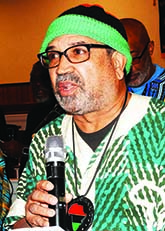
John Lewis and the Promise and Failure of Civil Rights and Black Politics

By Makheru Bradley

On July 17 two iconic civil rights figures, Congressman John Lewis (80) and Rev. C.T. Vivian (95) transitioned to the spiritual world. Many pundits have discussed the symbolism of these icons passing on the same day, largely because their activism was deeply connected.
Lewis and Vivian studied theology at the American Baptist College in Nashville, Tennessee. They became disciples of nonviolent theoretician Reverend James Lawson. Along with James Bevel, Bernard Lafayette, Marion Barry, and led by Diane Nash, they made Nashville the epicenter of sit-in protests after those protests began in Greensboro (February 1, 1960). Lewis and Vivian joined the Freedom Rides, where Lewis was beaten in Montgomery, and they were both sent to the notorious Mississippi State Penitentiary at Parchman, after being arrested in Jackson.
In 1963 John Lewis became the chairman of the Student Nonviolent Coordinating Committee (SNCC), while Rev. Vivian became one of the top aides to Dr. Martin Luther King in the Southern Christian Leadership Conference (SCLC). Lewis and Vivian helped to organize the 1963 March on Washington and they became key players in the Selma movement for voting rights. Vivian was beaten by Selma’s white supremacist sheriff Jim Clark and on Bloody Sunday (March 7, 1965) Lewis would become one of the most well-known casualties of the barbaric violence of Alabama state troopers and Jim Clark’s calvary.
SNCC and the MFDP
Certainly John Lewis, like his SNCC comrades, was courageous at a time when the most simplistic act of defiance could get you killed. As chairman of SNCC from 1963-1965, John Lewis was part of the mass movement that forced American Apartheid to capitulate. Lewis remained committed to his belief that American society could be peacefully reformed into a multi-racial democracy. This was probably the opinion of the majority of people in SNCC in the early 60s. Merging into the Democrat Party was the next logical step for that majority.
A minority within SNCC, represented by people like Kwame Ture (Stokely Carmichael), James Forman, Mukasa Willie Ricks, Ruby Doris Robinson and Cleveland Sellers were struggling against a system of control -- American Apartheid, which eventually led them to see the pitfalls of reforms. They saw self-determination and independent politics as the route to real power.
The ideological differences within SNCC became more prominent after the 1964 Democrat National Convention (DNC) in Atlantic City. In April 1964, the Mississippi Freedom Democratic Party (MFDP) was founded to challenge the segregated Democrat Party of Mississippi. SNCC was the driving force behind the 1964 Freedom Summer campaign for voting rights, and its activism emboldened the challenge of the MFDP at the Atlantic City DNC. The Democrats refused to seat the MFDP, even after the gut-wrenching and dynamic testimony of Mrs. Fannie Lou Hamer. The MFDP rejected the DNC compromise and returned to Mississippi. However, after returning, some members of the MFDP accepted a deal to merge into the Democrat Party.
I’ve always believed that the decision by the Mississippi Freedom Democratic Party to relinquish their independence and join the Democrat Party was one of the most significant lost opportunities of the 20th century for Afrikans in America. With Afrikan Americans being the majority in the Mississippi Delta they did not need the Democrat Party to control the politics of that area. Had the MFDP remained independent, as Kwame Ture, James Forman, and other MFDP organizers hoped they would, the entire direction of Afrikan American politics could have been different and more beneficial to the masses of Afrikans in America.
The betrayal of those who invested the most
When the MFDP decided to relinquish its independence the die was cast to create a class of Afrikan American neocolonial political operatives -- a comprador class of “leaders.” These politicians are dependent on their umbilical relationship to neoliberal white supremacy and the corporate Democrats to maintain their positions.
Like the MFDP, merging into the Democrat Party was the next logical step for John Lewis and people in SNCC who thought like him. He believed in the reform process, transactional leadership, versus transformative leadership, as exemplified by Omowale Malcolm X. Lewis was first elected to represent Georgia’s 5th District in 1986.
American politics is based on transactions, not moral conscience. In the “you feed my dog and I’ll feed yours” transaction, the white politician’s dog is a pit bull and the Black politician’s dog is a poodle. Both dogs are being f0ed, but one is consuming disproportionately more resources than the other. This is reflected in the failure of the Black politicians to deliver economic development for their constituents. In many of America’s urban centers, in 1970, over 70 percent of Black males aged 16-64 were employed. By 2010, the percentage employed had fallen to between 43 and 58 percent in many of those cities. In Charlotte, 79.2 of Black males were employed in 1970. Only 56.5 were employed in 2010. (For references see “Race and Male Employment in the Wake of the Great Recession” by Dr. Marc V. Levine, University of Wisconsin-Milwaukee: Center for Economic Development)
The greatest failure of the assimilationist/neocolonialist strategy is that the people who invested the most in the movement for civil and voting rights, the grassroots Black people of the Deep South, benefited the least. Dallas County (Selma), Alabama is perhaps the most prominent example of that failure. With one of the highest poverty rates in the US, "it's probably worse than it's ever been," said Sheyann Webb Christburg, 58, a Selma native and participant in the Bloody Sunday march. "People have spent so much of their blood, sweat and tears fighting to improve things, and even 50 years later, you're still seeing much of the same." The city's majority-Black east side reveals neighborhoods that resemble New Orleans after Katrina. A UN report in 2017 said, Alabama has the worst poverty in the developed world. That poverty is concentrated in Alabama’s Black Belt, where raw sewage running through yards is not uncommon.
To break these repetitive cycles
The heroic 1960s efforts of John Lewis and C.T. Vivian got us to a point. We don’t get to Black Power without going through the sit-ins, Freedom Rides, Birmingham, Freedom Summer, and Bloody Sunday.
We've succeeded in tearing down structures of white supremacy, but their foundation (a mass-based philosophy/culture supported by capitalism) remains intact. Thus, every time we tear down, Chattel Slavery and American Apartheid, e.g., they build another structure on the foundation. Neocolonial politics is part of the current structure of white supremacy.
We can’t continue to engage in the same strategies and expect different results. We’re caught in a vicious cycle between reforms and oppression that must be broken.
Dr. Martin L. King said: “A true revolution of values will soon cause us to question the fairness and justice of many of our past and present policies. On the one hand we are called to play the Good Samaritan on life’s roadside, but that will be only an initial act. One day we must come to see that the whole Jericho Road must be transformed so that men and women will not be constantly beaten and robbed as they make their journey on life’s highway. True compassion is more than flinging a coin to a beggar. It comes to see than an edifice which produces beggars needs restructuring.”
For more from the author, follow his blog Makheru Speaks.


